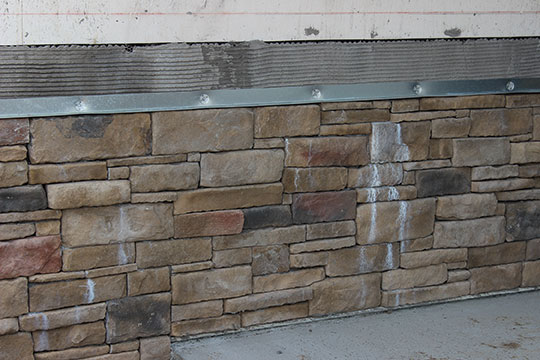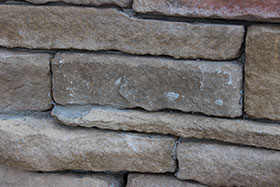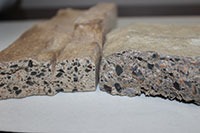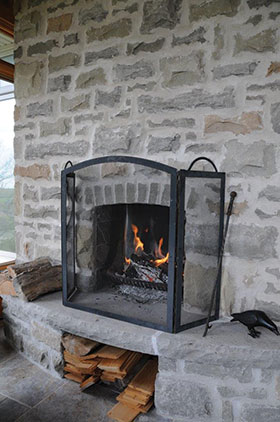Manufactured Stone
Easy Does It: Cleaning Manufactured Stone
Cultured stone photography courtesy of Jeremy Douglas
 |
| Mortar isn’t the only thing that will need to be cleaned from the stone’s surface after installation. Any calcium extruding from the mortar joints will need to be cleaned before it has a chance to build up and become extremely problematic, again requiring more aggressive cleaning and possibly damaging the surface of the adjacent stone. |
Manufactured stone is extremely fragile, and cleaning experts always are cautious when recommending how it be cleaned. From stone to stone, characteristics can vary greatly regarding aggregates, color added, etc. – While one manufactured stone can take a more effective cleaning procedure, a psi of 400 will wash the color right out of another. Chemical manufacturers simply cannot put just one cleaner on the market to clean all manufactured stones in the same way.
Cultured stone isn’t brick, and it can’t be cleaned as if it were. Not only must you consider what the stone is comprised of, but you need to factor in timing, your water source, the integrity of the coloring, the cleaning agent and method, and more.
 |
 |
 |
|
| Ron Baer | Jeremy Douglas | Al Morris |
To get a good read on the basics for cleaning manufactured stone, Masonry consulted three experts in this field. We sat down with Ronald W. Baer, president of Kem-O-Kleen, a company that has manufactured equipment for masonry cleaning for more than 40 years; Jeremy Douglas, CSI, CCPR, director of architectural services for Hohmann & Barnard, who has more than 15 years of experience in the masonry industry in addition to working with other various wall systems; and Al Morris, national sales manager for PROSOCO, who has been involved in the cleaning, coating and restoration industry for the last 20 years. Following is what they had to say.
Masonry: Discuss the timing of cleaning different types of manufactured stone projects.
Ron Baer: The major instruction for manufactured stone is to follow instructions – instructions for installation, for using a cleaner, and for maintenance.
Jeremy Douglas: Timing is critical in cleaning newly laid manufactured stone, because you’ll need to make certain the mortar doesn’t cure and harden beyond a point at which its removal is ineffective. Yet, the mortar also needs enough time to cure, so its color and texture are largely unaffected. I think the best practice is to ensure any of the larger mortar tags are removed during the installation process, and then try to clean the leftover residues between seven and 14 days after installation.
Al Morris: You always want to clean a substrate as soon as possible. The longer you wait, the harder the mortar gets. This makes it more difficult to remove, which would lead using harsher cleaning techniques. This could cause the manufactured stone to be damaged.
 |
|
| Even when applying stone from the top down mortar will inevitably find its way to the face of the adhered veneer, requiring cleaning. This also especially occurs when grouting a stone profile that’s not stacked. |
Masonry: How does the integral nature of the coloring affect the way a manufactured stone is cleaned?
Baer: Manufactured stone veneer typically will be installed on a vertical sub-surface with a cement mortar mix. Care should be taken to keep excess mortar from coming into contact with the face of the finished stone. If excess mortar does come into contact with the face of the finished stone, do not wipe the mortar off. Doing this will cause the mortar to smear and will make the removal process harder. Wait until the excess mortar dries to a crusty consistency, and then flake it off using a soft bristle brush. Do not use a wire bristle brush, as this will damage the face of the stone. Do not allow the mortar to completely dry on the face of the stone. If the mortar is allowed to completely dry, you will not be able to remove it.
Douglas: Not all manufactured stone products are made the same way. Some are colored integrally with mineral embellishments mixed throughout the stone, while others tend to hold color just at the surface (post-cast application). In cleaning these two different types, one has to be much more delicate with a surface applied colorant, as both chemical bleaching and wand pressure are likely to facilitate its partial removal.
Morris: One of the biggest cleaning issues with manufactured stone is this: If the stone is not integrally colored, if a cleaner is used that is to aggressive, then the color can be removed. So care must be taken to determine whether the stone is integrally colored, or if it has a Portland cement colored finish on the surface.
| Product Watch |
CalStar is expanding its line of cast stone products with a 24-inch-long (nominal) unit with a chiseled appearance that emulates natural, cut limestone. The chiseled-texture units have a bed depth of four inches (nominal) and are available in four heights: four, eight, 12 and 16 inches (nominal). CalStar’s cast stone starts with molds mastered from real stone, contributing to an authentic look. By using several different faces per size and an alphanumeric installation guide inscribed on each piece, CalStar ensures installers can place the units in patterns that are not repetitive to the eye. The CalStar staff will assist designers with developing an installation hierarchy. In addition, units are available with a chiseled end for use in corners.Unlike some products, the units are suitable for at-grade applications and, therefore, eliminate the need for starter courses. Other uses include band courses, wainscoting and window accents. The chiseled-texture units have a bed depth of four inches (nominal) and are available in four heights: four, eight, 12 and 16 inches (nominal). CalStar’s cast stone starts with molds mastered from real stone, contributing to an authentic look. By using several different faces per size and an alphanumeric installation guide inscribed on each piece, CalStar ensures installers can place the units in patterns that are not repetitive to the eye. The CalStar staff will assist designers with developing an installation hierarchy. In addition, units are available with a chiseled end for use in corners.Unlike some products, the units are suitable for at-grade applications and, therefore, eliminate the need for starter courses. Other uses include band courses, wainscoting and window accents.
The cast stone products are made with CalStar’s process that incorporates up to 18 percent recycled content and eliminates the need for Portland cement, used to bind concrete masonry products; for calcium silicate materials, which require energy-intensive autoclaving; or for kiln-firing, typical of traditional clay brick. As a result, each product requires less energy to make as well as having a lower carbon footprint. The chiseled-face units are available in any of CalStar’s monotone colors. For more information, visit www.calstarproducts.com. |
Masonry: How do you determine pressure and volume for each project? What about accessories, like brush types?
Baer: Because most of the coloration, beyond just the base color of the concrete (which provides the individuality of each stone and the interest of the installation) is on the surface of the stone, great care needs to be taken to preserve the exposed color. New stones, as well as existing stones, should be cleaned with special-purpose manufactured stone cleaner. If you are going to use a pressure washer to wash the brick, unless you are using a Kem-O-Kleen masonry cleaning machine, you should not use the washer to apply the manufactured stone cleaner. Though it contains only a small percentage of acid, the acid will deteriorate the water pump, hoses and wand. When using any pressure washer, the pressure needs to be minimal. It would be advisable to use a 40-degree water nozzle to assure there is not excess pressure and the wand is held away from the work.
Douglas: As with most masonry, the rule is “as gently as we can to achieve the desired result.” I approach from this philosophy with regard to both chemical dilution and machine pressure, or whether I decide to use a low-pressure washer at all. Sometimes a bucket, brush and garden hose work just fine. And, as for brushes, always use a light nylon or natural brush. I’ve seen plenty of good-looking manufactured stone ruined with a metal bristled brush in haste.
Morris: Minimum pressure must be used, if any, on manufactured stone. If a brush is used, it must be a natural masonry brush designed to be used on mortar. The use of wire or a brush that is too stiff can cause damage to the stone.
Masonry: Why is an understanding of the reaction of the cleaner on the manufactured stone and its components important?
Baer: It is important to remember that even if the high pressure water sprayer is rated at 3,000 psi – a typical rating for a high pressure washer – with a 40-degree nozzle and the wand held just one foot from the surface, the water will hit the stone at only 1.3 psi. If you have no other means of applying the chemical, then a soft masonry cleaning brush can be used. After completely rinsing the surface, brush the chemical on the wet surface at the specified dilution rate. You can then rinse well with a pressure washer or garden hose and nozzle.
Douglas: Very simply, in chemical cleaning, we are trying to get a reaction between the chemical and the Portland component of the mortar in order to clean it away, yet that cementitious element also is present in the cement, though in a cured state, still reactive. The idea is to catch the mortar at a time during its curing process when we can affect its firmness and solidity with a mild cleaning solution, but at the same time not etch the cementitious stone. It’s also important to note how reactive the colorant in the stone is to the solutions we are putting on it, as well as the reactivity of colored mortar if there are mortar joints present.
Morris: Understanding the reaction is important, because you prevent damage to the manufactured stone. Because the stone and motor are both based on the same material, the use of an aggressive cleaner will remove the mortar as well as damage the manufactured stone.
 |
|
| Because the aesthetic surface of the manufactured stone is so thin, it requires a very gentle cleaning process. An integrally colored stone as pictured on the left will retain a more natural look even if some of that surface is etched because it is colored in a similar palette. |
Masonry: How is cleaning mortar from a newly finished manufacturing stone project going to different from cleaning older, stained manufactured stone?
Baer: No matter how you intend to clean the surface, be sure to test the process either on an extra stone or in an area where a change in the color will be least noticeable. According to Steve Gehring, VP of Unlimited Designs which produces Rocky Mountain Stone Products, manufactured stone cleaners will not remove stains such as tar and hydraulic oil, stains that can be created by other trades on a jobsite. Therefore, it is important to protect manufactured stone from stains during construction. Once installed, these and other types of stains that penetrate the surface will probably not be removable. However, manufactured stone cleaner will remove atmospheric surface dirt and grit, leaving a like-new finish.
Douglas: Actually, the approach will be very similar: You will still have to know whether the colorant is integral or at the surface; and you will still want to approach the project with very little pressure and a chemical solution light enough not to harm the veneer. Essentially, all that will have changed is the chemical you’re using as you’re no longer trying to soften and rinse residual mortar away but are trying to suspend and lift away any dirt and grunge present on the surface.
Morris: The cleaning requirements that would be required to clean newly finished manufactured stone would be less aggressive, because it is new and usually cleaned within 10 days. With older or stained manufactured stone, you first need to identify what the stain is and then use the appropriate cleaner designed to that specific stain. You always want to start out with the least aggressive product that will do the best job, and always being aware that a product that is too aggressive can etch or damage the stone.
| Product Watch Arriscraft Building Stone |
 Arriscraft, manufacturer of all-natural products that emulate quarried stone, uses a cement-free, Natural Process technology to produce its residential Building Stone collection, backed by a lifetime warranty. Only three components are used in the Arriscraft production process: silica sand, hydrated lime and high-quality iron oxide pigments. Mixed together and pressed with 1,000 tons of pressure, they become durable, strong and intimately bonded. From there, stones are subjected to high-pressure steam and heat. This results in a calcium silicate hydrate binder, creating a 100 percent dimensionally stable, non-fading man-made stone unit.Manufactured as “full bed” for standard installation (similar depth to traditional brick), Arriscraft Building Stone allows for a traditional masonry wall cavity system offering moisture protection. The consistent “through-color” property of each product makes it possible to maintain original colors and textures, even after on-site cutting, chiseling and dressing. And, waterproofing is never required with these products.These materials work for exterior cladding, as they have been developed to endure extreme climatic conditions. Offered in a natural color palette, the same materials selected for the outside of a building also may be selected for interiors. All products support LEED sustainability objectives as well. Arriscraft, manufacturer of all-natural products that emulate quarried stone, uses a cement-free, Natural Process technology to produce its residential Building Stone collection, backed by a lifetime warranty. Only three components are used in the Arriscraft production process: silica sand, hydrated lime and high-quality iron oxide pigments. Mixed together and pressed with 1,000 tons of pressure, they become durable, strong and intimately bonded. From there, stones are subjected to high-pressure steam and heat. This results in a calcium silicate hydrate binder, creating a 100 percent dimensionally stable, non-fading man-made stone unit.Manufactured as “full bed” for standard installation (similar depth to traditional brick), Arriscraft Building Stone allows for a traditional masonry wall cavity system offering moisture protection. The consistent “through-color” property of each product makes it possible to maintain original colors and textures, even after on-site cutting, chiseling and dressing. And, waterproofing is never required with these products.These materials work for exterior cladding, as they have been developed to endure extreme climatic conditions. Offered in a natural color palette, the same materials selected for the outside of a building also may be selected for interiors. All products support LEED sustainability objectives as well.
For more information, visit www.arriscraft.com. |